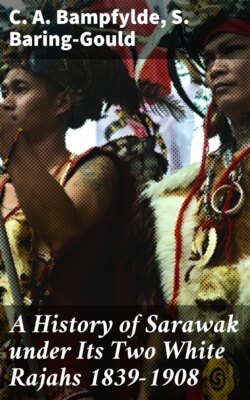Читать книгу A History of Sarawak under Its Two White Rajahs 1839-1908 - S. (Sabine) Baring-Gould - Страница 9
На сайте Литреса книга снята с продажи.
ОглавлениеTHE PART OF KUCHING SHOWN IN HEAD-PIECE OF PRESENT CHAPTER, AS IT NOW IS.
78. Camoen's Lusiad (Sir Richard Burton's translation.) Camoen here refers to the islands of the Malayan Archipelago, which he visited in his exile some 350 years ago.
79. St. John tells us that a few years before this an English ship that had put into the Sarawak river to water was treacherously seized; the Englishmen were murdered, and the Lascars sold into slavery.
80. Anglice, cat.
81. A short time before the commencement of this history this place had been attacked by the Saribas Dayaks, and 120 people were slain.
82. 3000 feet.
83. Spencer St. John, Sir James Brooke, 1879.
84. Mr. Brooke. He was a good-looking man. Capt. the Hon. H. Keppel gives his portrait, the frontispiece to vol. i. of his Expedition to Borneo of H.M.S. Dido, which is incorrectly entitled the portrait of Rajah Muda Hasim.
85. Spelt Sahib by Mr. Brooke in his letters and journals, and by others, but correctly his name was Sahap. He had a reputation for bravery, and was styled by the Sekrang Dayaks "Bujang Brani," the brave man.
86. There is no strict law of primogeniture in Bruni, otherwise Rajah Muda Hasim could not have been heir-presumptive. As he was of royal blood, and the prince most fitted to succeed, he was looked upon as the heir to the throne, and was so acknowledged (publicly in 1846) by the Sultan, and was therefore more correctly heir-apparent. At this time Sultan Omar Ali had two sons, and the eldest, also named Hasim, must have been about thirty-five years of age. There was a disgraceful harem scandal in connection with their birth, which pointed to their having been the sons of a Nakoda, or merchant. Though this appears to have been generally credited, Hasim nevertheless became the 24th Sultan in 1885.
It may be noted here that Omar Ali himself was only de facto Sultan, as he was never able to obtain the legal investiture which in Bruni constitutes an election to the throne de jure, and which confers upon the sovereign the title of Iang de Pertuan, the Lord who rules, the most exalted title, and one which he never assumed.
87. Or an abbreviation of Muhammad Husain. In former works he is incorrectly styled Moksain (for Matsain), following Mr. Brooke's published letters and journals, which were badly edited in regard to native names and words.
88. Mr. Brooke.
89. Mr. Brooke.
90. The Bruni, not the Sarawak Malays.
91. Mr. Brooke.
92. Idem.
93. By which he was generally referred to, both in documents and verbally, by the Malays of Bruni and Sarawak. "Rajah of Sarawak" was a complimentary title given to him by Europeans only. He has been frequently styled Muda Hasim by former writers; this would be unintelligible to a Malay.
94. Such was this ascendency that they became the founders of the present ruling dynasties of Bruni (Chap. II., p. 1), Palembang (Sumatra), Pontianak, Sambas, Mindanau, and Sulu, and probably of other native states.
95. Land-Dayaks.
96. Shortly before Rajah Brooke's arrival, Sherip Sahap with a large force of Sekrang Dayaks had attacked the Sau tribe of Land-Dayaks in Upper Sarawak. Many were killed, their villages plundered and burnt, and nearly all the surviving women and children, to the number of some two hundred and fifty, carried off into slavery. The Rajah eventually recovered nearly all.
97. Meaning Rajah Muda Hasim.
98. Bruni.
99. Duit, Malay for a cent.
100. Rajah Brooke.
101. "I admit that Bruni has its points, but what irony to compare for a moment the city of marble palaces with the mass of miserable huts which a single match could easily reduce to ashes."—Beccari, op. cit. The Rajah called the place a "Venice of hovels." Mercator in his Atlas describes it as "being situated on a saltwater lagoon like Venice," hence probably it became known as the Venice of Borneo.
102. Kota batu, stone fort. The name still remains. It was built towards the close of the fifteenth century by Sherip Ali, the first Arab Sultan, with the aid of the Chinese subjects his wife's mother had brought to Bruni. The city was then nearer the mouth of the river. It was moved to its present position by Sultan Muadin about 200 years ago.
103. Magellan, Hakluyt Society, and the Portuguese Jorge de Menezes, who visited Bruni five years after Pigafetta, notices that the city was surrounded with a wall of brick, and possessed some noble edifices. Other early voyagers describe the sultans and rulers of Malayan States as maintaining great style, and their equipments—such as swords of state, saddles, chairs, eating and drinking utensils—as being of pure gold. Allowing for some exaggeration, this would still point to a former condition of prosperity which enabled rulers and nobles to keep up a pageantry which has long since vanished.
104. This malformation, according to the laws of Bruni, would have disqualified him for the throne, for these provide that no person in any way imbecile in mind or deformed in person can enjoy the regal dignity, whatever title to it his birth might have given him.—Sir Hugh Low, op. cit. p. 108.
105. Saya, or more correctly, sahaya (mis-spelt suya in the Rajah's badly edited journals) is the Malay for I, mine; so amigo saya would be, My friend. Amigo was one of the few Spanish words the Sultan had.
106. Established in 1855.
107. Afterwards Admiral of the Fleet. He died, January 1904.
